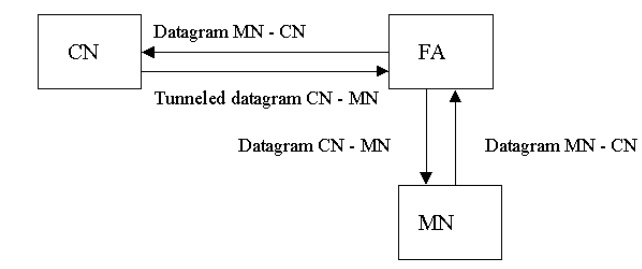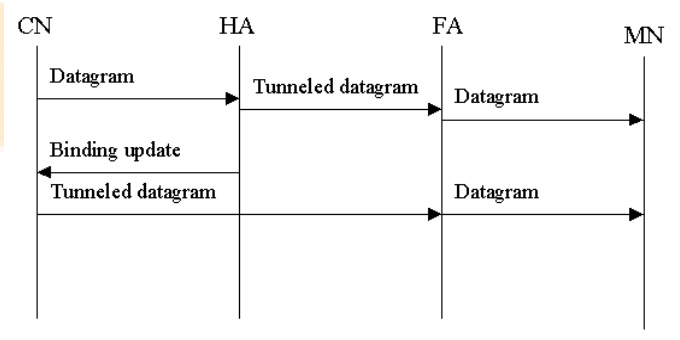Chapter: Mobile Computing : Mobile Internet Protocol and Transport Layer
Route Optimization
ROUTE OPTIMIZATION
Mobile IPv4 route optimization
Mobile
IPv4 route optimization is a proposed extension to the Mobile IPv4 protocol. It
provides enhancements to the routing of data grams between the mobile node and
to the correspondent node. The enhancements provide means for a correspondent
node to tunnel data grams directly to the mobile node or to its foreign agent
care-of address.
Route optimization messages and data structures
The route
optimization extension adds a conceptual data structure, the binding cache, to
the correspondent node and to the foreign agent. The binding cache contains
bindings for mobile nodes'
home addresses and their current care-of addresses. With the binding the
correspondent node can tunnel data grams directly to the mobile node's care-of
address.
Every
time the home agent receives a datagram that is destined to a mobile node
currently away from home, it sends a binding update to the correspondent node
to update the information in the correspondent node's binding cache. After this
the correspondent node can directly tunnel packets to the mobile node. Thus
direct bi-directional communication is achieved with route optimization.
Direct routing with route
optimization and foreign agent care-of address.

Route optimization adds four new UDP-messages to
the Mobile IPv4 protocol:
Binding
update informs the correspondent node or foreign agent of the mobile node's new
location. It is sent by the home agent or in the case of previous foreign agent
notification, by the new foreign agent, as shown in Figure 4. The binding
update contains the care-of address and the home address of the mobile node and
also the lifetime of the binding. It also must contain a mobile IP
authentication extension. An identification number may also be present to
provide a way of matching updates with acknowledgements and to protect against
replay attacks.
Binding
acknowledgement is sent by the correspondent node or the foreign agent in
response to the binding update. It contains the mobile node's home address and
a status code. It also contains an identification number, if there was one in
the corresponding binding update.
Binding
request is sent by the correspondent node to the home agent to request a
binding update. It contains the home address of the queried mobile node and
possibly an identification number.
Binding
warning is sent by the previous foreign agent in response to receiving a
tunnelled datagram for a mobile node for which it has a binding and for which
it is not acting as the current foreign agent. The binding warning is sent to
the home agent. It contains the home address of the mobile node and the address
of the correspondent node that does not have up to date information of the
mobile node's current care-of address. With this information the home agent can
send a binding update to the correspondent node.
Binding update to correspondent
node

The effect on static routes
As the
correspondent node learns the care-of address of the mobile node from the
binding update, it can tunnel data grams directly to the mobile node's care-of
address . Thus only the first data grams are routed via the home agent. This
reduces the network load and also reduces the delays caused by routing. Thus
the optimization is valuable to mobile nodes that visit networks located far
from their home agent.
However,
the overhead caused by tunnelling is not decreased. The correspondent node's
use of minimal encapsulation is a partial remedy, if both the encapsulator and
the decapsulator support it. Ingress filtering may also prevent the mobile node
from sending data grams directly to the correspondent node. The use of direct
reverse tunnelling from the care-of address to the correspondent node's address
is a possible solution to ingress filtering. However, it is not possible with
foreign agent care-of addresses, since the current reverse tunnelling standard
requires the foreign agent to tunnel all packets to the home agent of the
mobile node.
Smooth handoffs with route optimization
In the static case the protocol is fairly
simple, but handoffs somewhat complicate the situation. When the correspondent
node has an out of date entry for the mobile node's care-of address it tries to
send the tunnelled datagram to the mobile node's previous location and the
datagram is lost. To solve this problem the protocol includes the previous
foreign agent notification mechanism, which adds a binding cache to the foreign
agent.
When a
mobile node moves to a new sub network it sends a registration request to the
new foreign agent. The registration request may contain a previous foreign
agent notification extension. Upon receiving such a request the foreign agent
builds a binding update and sends it to the previous foreign agent. The
previous foreign agent can then, after authenticating the update, create a
binding for the mobile node. With this binding it can re-tunnel data grams to
the mobile node's new care-of address. The re-tunnelling requires foreign agent
care-of addresses in order for the agents to act as tunnel endpoints.
The
previous foreign agent notification mechanism provides temporary localization
of the handoffs. It does not reduce the signalling load between the home agent
and the mobile node, but reduces the number of data grams lost due to
correspondent nodes with out-of date bindings.
Security considerations
Since the
correspondent nodes and foreign agents have binding caches, which change the
routing of data grams destined to mobile nodes, the binding updates must be
authenticated. The authentication is performed in a similar manner as in base
Mobile IPv4. All binding updates contain a route optimization or smooth handoff
authentication extension. This extension contains a hash, which is calculated
from the datagram and the shared secret.
The correspondent node and the mobile node's home
agent need a security association. This association is used for the
authentication of the binding updates. Since the mobile node sends a binding
update directly to its previous foreign agent, they also need a security
association. If the security associations are not preconfigured they can be
established via a key management protocol such as ISAKMP or SKIP.
General deployment requirements
In order to make use of the binding updates the
correspondent nodes must be able to process and authenticate them and be able
to encapsulate data grams. To establish this, the network stacks of the
operating systems require changes. Since correspondent nodes need to establish
a security association with the home agent and foreign agents need to establish
one with the mobile node, a widely deployed key management system is obviously
needed. Otherwise only nodes
with statically configured security associations can benefit from the binding
updates.
Mobile IPv6 and route
optimization
Main characteristics of Mobile
IPv6
Whereas Mobile IP was added on top of the
IPv4 protocol, in IPv6 mobility support is built into the IP-layer. In mobile
IPv6 route optimization is an essential part of the protocol. Mobile nodes have
a binding update list, which contains the bindings other nodes have for it. Correspondent
nodes and home agents have a binding cache, which contains the home and care-of
addresses of mobile nodes they have been recently communicating with. All
signalling is performed via destination options that are appended to the base
IPv6 header. Thus all signalling traffic can be piggybacked on data grams with
a data payload, as in Figure 5.

The
destination options are:
·
Binding update option, which is sent by the mobile
node to its home agent and correspondent nodes to inform them of a change of
location.
·
Binding acknowledgement option, which is sent in
response to the binding update.
·
Binding request option, with which a node can
request a new binding update from the mobile node, when the binding is about to
expire.
• Home address option, which the mobile node
appends to all data grams it sends while away from its home network. The home
address option is used to avoid the negative effects of ingress filtering by
using the topologically correct care-of address as the source address and
including the home address in the option. The receiving node will then copy the
home address to the source address before passing the packet to any transport
level protocol.
All care-of addresses in Mobile IPv6 are
co-located; thus foreign agents are not a part of the protocol. Since all nodes
are only required to understand the home address option, triangle routing will
occur also with mobile IPv6. However, if the correspondent node implements the
draft fully, only the first data grams it sends will be routed via the home
agent. The mobile node always sends a binding update to the original sender of
a tunnelled datagram. With this binding the correspondent node can send data
grams directly to the mobile node using a routing header.
A datagram
with a routing header contains the care-of address as the destination address
and the home address in the routing extension header as the final destination.
Thus the datagram will be normally routed to the care-of address. When the
mobile node receives a datagram with a routing header it swaps the final
destination with the destination address field. The home address option and the
routing header make the mobility transparent with direct routing.
The Effect on Routing
By using
direct routes in both directions the consumption of network resources is
minimized. The 40-byte IPv6 headers consume extra bandwidth when compared to 20
byte IPv4 headers. However the use of routing header and home address option
removes the need for constant tunnelling, thus decreasing the bandwidth
consumption. Although they both add overhead to packets they still are
considerably smaller than IPv6 headers, which would be used in tunnelling. The
destination options used for signalling can be piggybacked [4] which decreases
the signalling overhead considerably, since the options are relatively small
when compared to UDP packets.
The effect on handoffs
The IPv6
mobility support provides the previous router notification mechanism, with
which the amount of lost of packets in handoffs can be reduced. In IPv6 the
mobile node sends a binding update directly to the previous router, which
consumes more bandwidth but is faster than the mechanism used with Mobile IPv4
route optimization.
Problems solved
Mobile
IPv6 provides improvements on routing and signalling efficiency. As the
signalling can be mostly piggybacked on data packets there will be considerably
less signalling overhead between the mobile node and the correspondent nodes
than in mobile IPv4 route optimization between the home agent and the
correspondent nodes. The minimum requirements for the correspondent node
provide at least triangle routing even in the worst case, since care-of address
can be used as the source address. Hosts that are likely to communicate with
mobile nodes will probably implement the binding cache and communicate directly
with the mobile node. In both cases the routing saves network capacity and
decreases delays, when compared to reverse bi-directional tunnelling between
the mobile node and correspondent node.
The key
management problem is not solved Mobile IPv6 does not solve the key management
problem, but the integration of IPSec into IPv6 is likely to result in support
for key management protocols in most operating systems implementing IPv6.
Related Topics